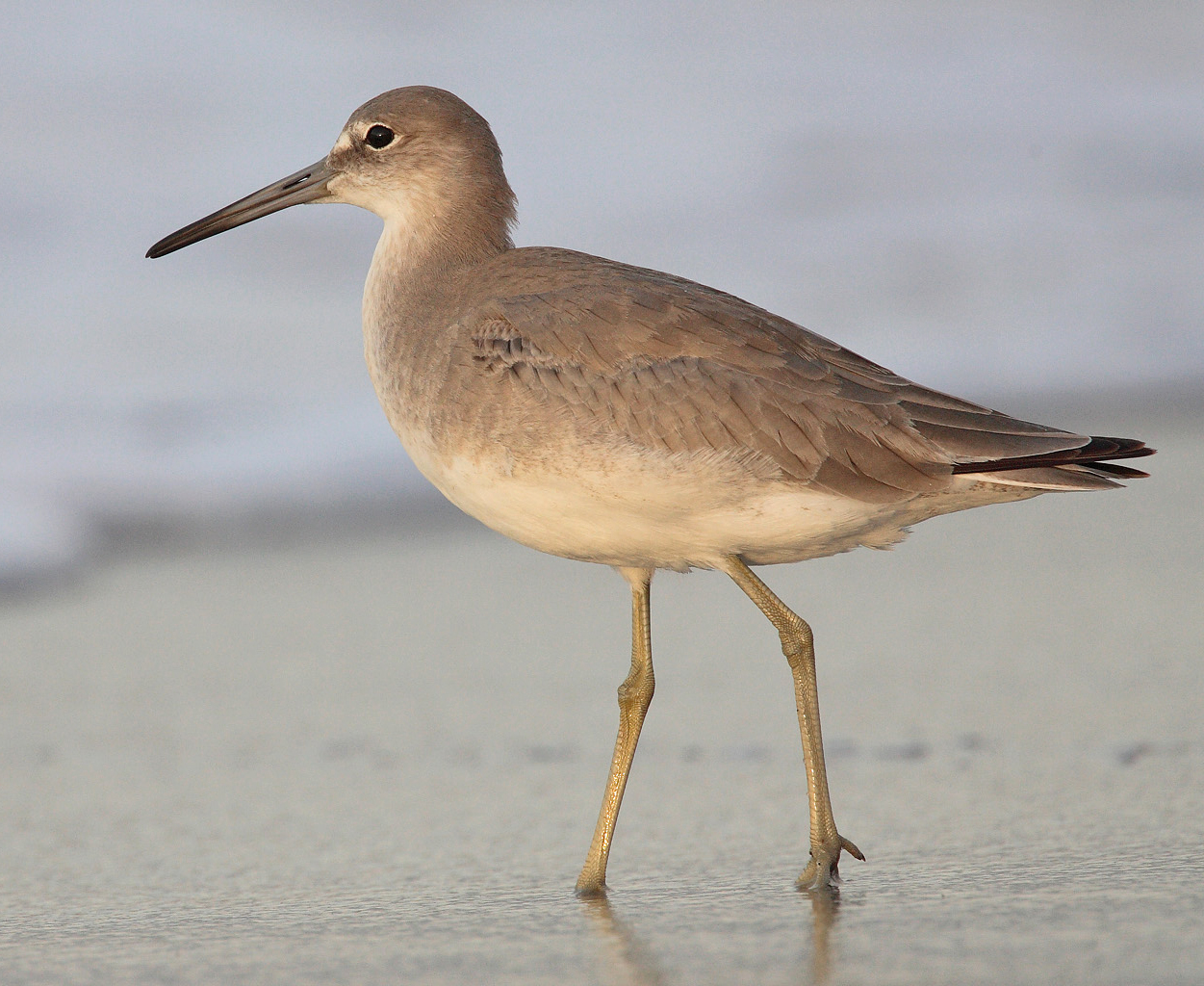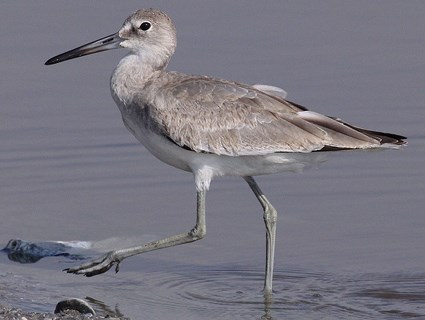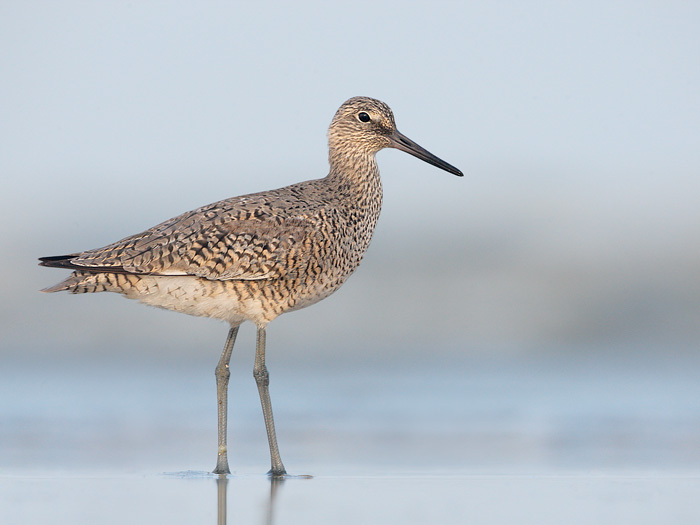Willet
Willet (Tringa semipalmata ) in simplicity dress
The Willet (Tringa semipalmata ) is a species of bird in the family of the Waders, its two subspecies differ markedly in their environmental claims. The western subspecies T. p. inornata breeds in inland swamps in the Prairie Pothole Region and the Great Basin in the interior Northwest America; the nominate populated the eastern coast of North America from Newfoundland to Tamaulipas as well as the West Indies and breeds in salt marshes and brackish marshes.
The Willet is unremarkable gray brown patterned in breeding plumage, colored beige brown rather monochrome simplicity in dress, but falls in flight by a high-contrast, black and white wing pattern. The area vocals ( Sample ), which can be described approximately with pill -will- willet earned him his English name Willet. Long the species was placed in the monotypic genus Catoptrophorus. Studies of mitochondrial DNA have shown, however, that the Willet is to incorporate in the genus Tringa.
- 6.1 Pair formation and courtship
- 6.2 Nest building and nest
- 6.3 breeding and rearing of the young
Description
The Willet is as big as a bar-tailed godwit and the largest member of its genus with a body length of 33-41 cm. The weight between 200 and 330 g Gender not differ with respect to the plumage, but the female is slightly larger. The most striking feature of the species is in all the dresses contrasting wing pattern - a white band, which is curved on the arm wing and centered over the otherwise black hand wing. Accordingly, it is also present on the lower wing. Here, the under wing-coverts are also almost completely black. The iris is dark brown. The beak coloration is dependent on age, season and subspecies belonging and varies from black, black with flesh-colored base to blue- gray with black tip. Legs and feet are greyish. Between the front toe webs are formed, which is greater between the outer and the middle toe as those for internal toe out.
Eastern Willet in breeding plumage, flying
Willet with clearly visible wing patterns
Western Willet ( see T. inornata ) in breeding plumage
Adult clothes
Adult birds of the nominate form are fine dashed whitish- dark brown in breeding plumage on the head, neck and anterior chest. Before the eye a bright eyes glancing over is pronounced, which continues at best indistinct above and behind the eye. Chin and throat are brightened somewhat. Shoulder and back feathers are dark brown with gray-brown tips and implied, marginalized harness. The longest scapulars are gray-brown with darker banding on the edge implied. During the mid- belly are white below the breast and under tail-coverts, the feathers are tinged with yellowish beige on flanks and lower breast and carry a multi- v -shaped harness that goes to the center of the chest in the finer penciling. The coverts are predominantly gray-brown or gray-brown finely banded. In the middle coverts there is a dark banding, which is sometimes coarser and wider to the shield springs. The large coverts get to hand wing towards an ever -widening, white border and loosely scribbled spring centers. The inner secondaries are completely white, the outer ones are blackish brown on the distal part, so that the white bases form a band that continues to the basal part of the otherwise black primaries. The primary coverts are dark brown to black. The Bürzelfedern contribute to lead- gray background, a dark, subterminales band. The upper tail-coverts are white. The tail feathers are on the distal part of gray -brown with blackish, scrawled implied banding on the basal portion white.
The simplicity dress is oberseits much more uniform, but interspersed with fine dark shafts. Head, neck, back and shoulder feathers are beige gray, the lower sides of the head and the anterior neck but it brightened considerably. The game over the reins of the eye ring, chin and throat are whitish bright on the flanks and sides of the chest, the beige brown the top goes into the whitish underside. The coverts are banded scrawled on a white background gray. The coverts and shield springs are beige brown as the rest of the top. Otherwise, the wing pattern corresponds to the breeding plumage. The rump feathers is lead- gray. The upper tail-coverts are whitish in the basal part and then go scrawled in the light gray of the central feathers on. The outer sides of the tail feathers are bright whitish to.
Youth clothes
The juvenile plumage is similar to the Simple dress but is in the gray games overall brownish, with dark shaft lines missing part. The rump is colored like the top and the upper tail-coverts are brownish in part. Back and scapulars, and upper wing-coverts are characterized by dark beige Subterminalbänder and end seams or slightly banded. In the first finishing dress the wing feathers of youth dress still remain and act then removed right.
Dissemination
The distribution area of the mud offender is divided into two parts in a Western presence in the interior of North West America and one on the Atlantic coast and the West Indies.
The western part of area extends over the southeastern Alberta, southern Saskatchewan and southwestern Manitoba. In the U.S., it includes large parts of Montana, with the exception of the Southeast and the Rocky Mountains to the west. In North and South Dakota as well as in the far north of Nebraska, the species occurs north and east as well as locally and west of the Missouri River. In Oregon, they inhabited the Southeast, parts of the south in Idaho and Wyoming to the west and the eastern middle. In California it breeds in the far northeast, Nevada locally in the north, in Utah in the region of the Great Salt Lake and Colorado in two smaller deposits in the north.
The eastern subspecies colonized large parts of the Atlantic coast and the coast of the Gulf of Mexico. In Newfoundland, the Willet is rare breeding bird. On the Magdalen Islands, he broods may. He comes on the coasts of New Brunswick, before the Prince Edward Island and Nova Scotia. Furthermore, the breeding population on the east coast of North America ranging from southern Maine to northern Tamaulipas in Mexico. The species is also in the Bahamas, the Greater Antilles, the Cayman Islands and the Virgin Islands, Antigua, St. Martin and Barbuda breeding bird. Perhaps it is also found on Anguilla. The southernmost breeding area can be found on Los Roques. There are also numerous About Sommerer still in the north of South America. A breeding population of Yucatán has not been confirmed.
Hiking
The Willet is on the West Indies sedentary, while the remaining populations are long-, medium - or short-distance migrant, with northern populations of Canada draw the most. The breeding birds of the Maritime Provinces of Eastern Canada cross large tracts of the Atlantic, to spend the winter in northern South America. The western subspecies draws in part on the Pacific coast, but also partly along the Mississippi River on the east coast.
The breeding areas are cleared as early as the end of July, sporadically to last birds still hold on to September. Between August and November the type arrives in the wintering areas. The spring migration takes place from March and is completed in late June at the latest. The main arrival dates in the breeding areas, depending on the geographical location between mid-April and mid-May.
The main wintering areas range on the Pacific coast - apart from the occasional wintering further north - from Humboldt Bay in California southward. Some of the species occurs there also on inland waters such as the Salton Sea or in the San Joaquin Valley. To larger numbers of over-wintering on the average Virginia southward find on the east coast. The winter area then extends further over the coasts of Central and South America - on the west coast to the middle of Chile and on the east coast to southern Brazil and Uruguay. This also includes the Galapagos Islands, Trinidad and Tobago and the islands off the coast of Venezuela.
As Irrgast the Willet in Hawaii and very rarely was found in Europe.
Habitat
Although the two sub- species occur in similar habitat types, but differ in their claims thus even more than the nominate form breeds almost exclusively in coastal, dominated by salt water habitats.
The Western Willet population breeds in the prairies of the Great Plains in the wet grassland or marshes with kurzrasigem, loose to sparse vegetation. Even semi-arid areas near water or with adjacent swamps are accepted. More rarely, the species is found in cultivated land. Only temporarily existing wet grassland is permanently preferred swampy terrain. At higher altitudes, the Willet is sometimes also found in salt marshes, salt flats or wooded mountain lakes. Semi-open or built-up area but apparently shunned.
The eastern subspecies whose distribution is restricted to the Atlantic coast, settled during the breeding season mainly salt marshes, as well as offshore islands and beaches with cord-grass vegetation. Locally it is also found in near-coastal pasture or arable land. Dominated by freshwater habitats but apparently mostly shunned.
On the spring migration the western subspecies is usually found in smaller inland swamps, in the fall also on the shores of larger lakes. In winter quarters, almost all coastal habitats from sandy beaches to rocky coast to Mangrove be consulted.
Nutrition
The Willet feeds on insects, small crustaceans, molluscs and Vielborstern. Occasionally, he also catches small fish. Among the insects dominate aquatic beetles living in the shellfish, crabs, which can account for a large portion of food in eastern subspecies. The search for food is done poking, sondierend or plowing with his beak in shallow water. Western Willet are mostly associated with lakeshores, found in shallow swamps or flood plains, birds of the eastern subspecies in mussel beds, tidal pools or cord-grass meadows.
Reproduction
Willet lead a monogamous marriage season. Due to the high breeding site and mate fidelity long term marriages are but in many places the rule. However, it can also happen that partners meet again on arrival at the breeding grounds, but later breed with other partners.
Pair formation and courtship
Part of the Willet meets already bred in the breeding areas and occupied areas, other couples formed during the Gruppenbalz, but also sometimes already join bred birds. Usually the Gruppenbalz is completed three weeks after arrival of breeding birds, but may recur during the entire breeding season - especially if the number of nest losses is high.
Balzflüge probably be carried out by non- paired birds. The male initiates the courtship and flies with wings held high and fluttering from secondaries. The female will also be flying on and keeps in the air under the male in whose calls it matches a duet. Then it follows the males in the slow descent to the ground.
Before copulation the male approaches the female with click-click - call from behind, lowers the tail and raises the ringing frequency. It highlights the flapping wings on the back, the wing beats are faster. This form of courtship lasts about 20-30 seconds. The gravid female lowers her head, crouches down, lifts the tail and calls click. The male jumps up and grabs the fluttering females during copulation with the beak in the neck.
Nest building and nest
Nests are found mainly between the end of April and the end of June, the most in the second half of May. In the maritime provinces of Canada, the main laying period is slightly later between mid-May and mid-July. In South Carolina, it comes after flash floods that wash away low-lying nests, often at a second trial phase in which make the couples involved replacement broods.
The choice of nest site headed the male, the female under Call to a point formed with beak or feet, and a rotation of the chest a nest hollow in tussocks and then stands up again. The female repeated on the rotational movement of the chest and is also into it. Before a decision is made, this process can be repeated three or four times.
The nest is usually hidden in some tall grass. It is shaped in a tuft of grass tussocks or either or consists of induced worn blades The Nistmulde is about 16 cm wide and 5 cm deep. It is lined with finer plant material.
The nest consists of four, slightly glossy, about 54 × 38 mm, spinning top shaped to oval eggs that are spotted irregular brown on beige to olive - beige ground. They are placed within 6 days at intervals of one to four days. Nachgelege often have fewer eggs.
Breeding and rearing of the young
Incubation period is about 25 days. Both parents incubate, with the females usually during the day and at night only the male sits on the nest. The young are precocial, which are guided by both parents and brooded over night. The female leaves the family about two weeks, the male remains up to two weeks longer at the boy. Sometimes it separates the fledging of them, but can also remain available for up to a week with them.










